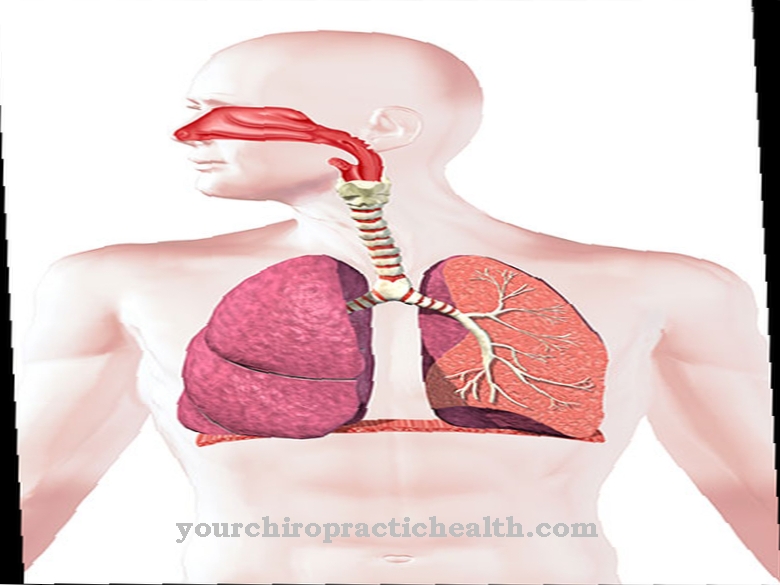The Hidrocytoma is a skin condition. Benign tissue develops at the outlets of the sweat glands in humans. The facial area is particularly affected.
What is a hidrocytoma?

© elvira fair - stock.adobe.com
Behind one Hidrocytoma a retention cyst is hidden, which mainly forms on the face. This is a cyst that develops from the occlusion of a gland. In a hidrocytoma, cystic papules form at the exits of the sweat glands. The cysts are mostly transparent to slightly bluish in color and easily recognizable with the naked eye.
The hidrocytomas primarily develop in the area of the cheeks or nose. It is a skin disorder in which tissue forms anew. This neoplasm is a benign neoplasm. The tissue comes from the adenoma family. These develop from the mucous membrane or the glandular tissue.
Depending on the affected sweat gland, doctors differentiate between eccrine and apocrine hidrocytoma. Even if this distinction has been refuted on the basis of new scientific results, it is retained until today for historical reasons. The eccrine hidrocytoma is also called a sweat gland retention cyst.
In the case of the apocrine hidrocytoma, doctors speak of the apocrine cystadenoma. Results of immunohistological studies show that eccrine hidrocytomas are able to produce apocrine antigens. These are messenger substances that can bind specific antibodies and certain receptors to themselves. For this reason, the distinction between eccrine and apocrine hidrocytoma is no longer necessary.
causes
The exact cause of the hidrocytoma is not known. Multiple occurrences of the hidrocytomas can occur in Schöpf-Schulz-Passarge syndrome. This is a genetic condition that causes cysts to form on the face. The cause of the syndrome has not yet been adequately researched due to its low incidence.
So far, scientists have assumed that it is inherited as an autosomal recessive trait. However, dominant inheritance cannot be ruled out. For the hidrocytoma this can mean that it is also a genetic disease. On the other hand, doctors are very good at documenting and describing the process in the body.
Due to the closure of the sweat gland, the secretion slowly builds up in the gland. In this way, a fluid-filled cyst develops with a spherical appearance. Researchers continue to study the functional activity of the sweat glands. The aim is to be able to offer precise explanations for the cause of hidrocytomas. So far, doctors have assumed that genetic reasons and excessive perspiration are responsible for the closure of the glands.
Symptoms, ailments & signs
The symptoms of hidrodocytomas include transparent to bluish cyst formations on the face. The bluish color is caused by a scattering effect of the light. This is known as the Tyndall effect and means that there is no blue color in the cysts. Hidrocytomas are completely painless for the patient.
This also applies if they occur in multiple numbers. The cysts are usually the size of the head of a pin. The hidrocytomas usually appear on the eyelid, the cheeks, and the two nostrils. However, other parts of the body can also be affected. Due to the force of gravity, the hidrocytomas can cause the eyelid to fold over if it occurs on the lower eyelid.
If they occur on the upper eyelid, this can also lead to a drooping eyelid due to gravity. However, there are no other impairments to the eye. Vision is not impaired. Therefore, the cysts are usually unpleasant for the patient because of their bluish color for cosmetic reasons. Provided there are no other illnesses, those affected have no further complaints apart from the cosmetic background.
Diagnosis & course of disease
The diagnosis is made by a doctor or dermatologist after visual contact. Spontaneous healing cannot be assumed. But it can happen. This means that the cysts cannot be assumed to regress on their own. As a rule, a steady increase in hidrocytomas can be expected without treatment.
Complications
The regions of the face in particular are affected by the hidrocytoma, so that many patients experience reduced aesthetics. This can lead to inferiority complexes or reduced self-esteem. In most cases, those affected are ashamed of the symptoms and feel excluded from social life.
Cysts that are blue in color form on the face. Usually these cysts are not associated with pain. Serious discomfort occurs when the cysts form directly on the eyes or on the eyelids, whereby these fold over automatically and thus extremely reduce the patient's vision. In most cases, however, there are no further complaints, so that only a cosmic intervention is necessary.
The cysts can easily be removed without complications. Surgical interventions or lasers are used for this. After removal, scars may develop, but no further symptoms arise. The life expectancy of the patient is not affected by the hidrocytoma. As a rule, however, it cannot be guaranteed that the hidrocytoma will not recur in the patient.
When should you go to the doctor?
Noticeable changes in the appearance of the skin on the face should always be examined by a doctor. Diseases that require treatment can be concealed behind this. If the symptoms spread or if they increase in intensity, a doctor should be consulted at the latest. If there are lumps, swelling or ulcers on the face, the observations should be presented to a doctor. Changes in welding activity give cause for concern.
If the changes persist for several weeks or months, a medical examination is needed. If cysts or papules form on the face, they should be clarified by a doctor. If the skin is discolored or the appearance changes, a medical examination is urgently recommended. Changes to the eyelid or impaired vision must be examined and clarified. If there is itching or open wounds on the face, there is an increased risk of further diseases.
Since there is a risk of sepsis in severe cases, consult a doctor at an early stage. Independent cosmetic treatment is not advisable in the case of a hidrocytoma. There may be complications or unwanted scarring. It is advisable to avoid using make-up items and other cosmetics until you have consulted a doctor. If pain sets in or if the facial muscles are impaired, a doctor should be consulted.
Doctors & therapists in your area
Treatment & Therapy
The treatment of hidrocytomas is mostly for cosmetic and less for health reasons. In addition, the cysts are made in functionally disruptive areas such as the eyelids. The hidrocytomas are usually removed via excision, laser beam treatment or marsupialization.
An excision is a simple surgical procedure with local anesthesia. This is only used in very few cases and with particularly large cysts. During treatment with a laser beam, the hidrocytomas are absorbed by healthy tissue through the radiation emitted by the laser. This is a thermal destruction of the cyst.
Depending on the number of hidrocytomas, several sessions may be necessary. Marsupialization is a special surgical technique that is often used on cysts the size of the head of a pin. Through an incision, the cyst is carefully opened with an incision and the fluid that has accumulated inside drains away.
Usually this is done with a small stitch tool. The puncture in the wall of the cyst results in natural drainage. This is a therapeutic drainage of the body fluid.
You can find your medication here
➔ Medicines against redness and eczemaOutlook & forecast
If there are no complications, the prognosis for the hidrocytoma is generally favorable. The skin changes are less a physical disease than a cosmetic blemish. If there are no further symptoms, treatment is therefore not necessary from a medical point of view for a large number of those affected.
If the cysts change, other diseases develop as a result of the mutation. These can have a less favorable prognosis. Regular control of the hidrocytoma is therefore advisable in order to maintain a good prognosis.
If the visual flaw of the cyst causes emotional stress, treatment is recommended. The optical changes can be removed cosmetically in various ways at the request of the person concerned. The methods used are routinely used, but are associated with the usual risks and side effects. In most cases the patient experiences permanent freedom from symptoms without any further sequelae.
If the hidrocytoma has caused a psychological complication, this must be included in the overall prognosis. If therapy is used, there is a good chance of recovery. The healing process usually takes several months or years. Without therapeutic support, the sufferer is threatened with chronic suffering. In addition, other life events or physical changes can intensify existing disorders and lead to a deterioration in health.
prevention
Carrying out preventive measures that promise a permanent solution is currently not known for hidrocytomas. Regular cosmetic treatments can be performed.
Aftercare
In most cases of a hidrocytoma, the patient has very few options for follow-up care. With this disease, the patient is primarily dependent on treatment by a doctor, otherwise further complications or a further worsening of the symptoms can occur.
Therefore, at the first symptoms or signs of this disease, the person concerned should consult a doctor to prevent further complications. Whether the hidrocytoma will lead to a reduced life expectancy for the person affected cannot be universally predicted. In most cases, however, the symptoms can be treated with very minor surgery. There are no particular complications.
After the procedure, the patient should take it easy and rest.The affected area should be well protected to prevent infection or inflammation. The person concerned should also take antibiotics, which should not be taken with alcohol. Regular examinations by a doctor are still necessary after the procedure in order to detect and remove another hidrocytoma early. Further follow-up measures are not necessary for this disease.
You can do that yourself
A hidrocytoma usually does not require medical treatment. Since the hidrocytoma mainly affects the regions of the face, the skin disease is perceived by those affected as an aesthetic flaw. A therapist should be consulted before this develops into emotional complaints. Especially in the case of chronic complaints, it is important to accept the conspicuous areas of the skin and not be restricted by them. People who still suffer psychologically from the cysts should seek treatment.
Even cysts that appear in functionally disruptive areas must be medically clarified and, if necessary, removed surgically. The most important accompanying measure is the use of the prescribed medication and care products. In the first few days after the procedure, the affected area must not be touched or irritated in any other way, as this can cause infections and, in the worst case, lead to permanent scarring of the skin.
So that the wounds can heal well, those affected should take it easy and eat a healthy and balanced diet. In addition, regular check-ups with the responsible doctor are indicated. If complications arise, the doctor's office must be visited immediately.

.jpg)


.jpg)




















.jpg)

.jpg)
